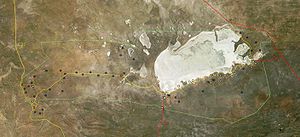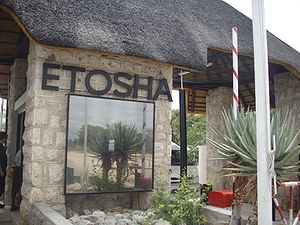
Etosha National Park
Encyclopedia


Kunene Region
Kunene is one of the thirteen regions of Namibia and home to the Himba ethnic group. Compared to the rest of Namibia, it is relatively underdeveloped...
of northwestern Namibia
Namibia
Namibia, officially the Republic of Namibia , is a country in southern Africa whose western border is the Atlantic Ocean. It shares land borders with Angola and Zambia to the north, Botswana to the east and South Africa to the south and east. It gained independence from South Africa on 21 March...
. The park shares boundaries with the regions of Oshana
Oshana
Oshana is one of the thirteen regions of Namibia. The name Oshana lends itself well to this region as it describes the most prominent landscape feature in the area, namely the shallow, seasonally inundated depressions which underpin the local agro ecological system...
, Oshikoto
Oshikoto
Oshikoto may refer to*Oshikoto Region, Namibia*Oshikoto Constituency, Namibia...
and Otjozondjupa
Otjozondjupa
Otjozondjupa region is one of the thirteen regions of Namibia. An outstanding landmark within this region is the Waterberg Plateau Park. Administration offices are based in Otjiwarongo which is the largest town in the region....
.
The Etosha Gates are named Otjovasandu Gate, Anderson Gate, Namutoni Gate, and Von Lindequist Gate.
History
Etosha was first established in 1907, when Namibia was a German colony known as South West AfricaSouth West Africa
South-West Africa was the name that was used for the modern day Republic of Namibia during the earlier eras when the territory was controlled by the German Empire and later by South Africa....
. At the time, the park’s original 100,000 km² (38,500 mile²) made it the largest game reserve
Game reserve
A game reserve is an area of land set aside for maintenance of wildlife for tourism or hunting purposes. Many game reserves are located in Africa. Most are open to the public, and tourists commonly take sightseeing safaris or hunt wild game....
in the world. Due to political changes since its original establishment, the park is now slightly less than a quarter of its original area, but still remains a very large and significant area in which wildlife
Wildlife
Wildlife includes all non-domesticated plants, animals and other organisms. Domesticating wild plant and animal species for human benefit has occurred many times all over the planet, and has a major impact on the environment, both positive and negative....
is protected.
Fauna and flora
The Etosha Pan dominates the park. The salt panSalt pan (geology)
Natural salt pans are flat expanses of ground covered with salt and other minerals, usually shining white under the sun. They are found in deserts, and should not be confused with salt evaporation ponds.A salt pan is formed where water pools...
desert
Desert
A desert is a landscape or region that receives an extremely low amount of precipitation, less than enough to support growth of most plants. Most deserts have an average annual precipitation of less than...
is roughly 130 km long and as wide as 50 km in places. The hypersaline conditions of the pan limit the species that can permanently inhabit the pan itself; occurrences of extremophile micro-organisms are present, which species can tolerate the hypersaline conditions.(C.Michael Hogan. 2010) The salt pan is usually dry, but fills with water briefly in the summer, when it attracts pelican
Pelican
A pelican, derived from the Greek word πελεκυς pelekys is a large water bird with a large throat pouch, belonging to the bird family Pelecanidae....
s and flamingo
Flamingo
Flamingos or flamingoes are gregarious wading birds in the genus Phoenicopterus , the only genus in the family Phoenicopteridae...
s in particular. Perennial springs attract a variety of animals and birds throughout the year, including the endangered Black Rhinoceros
Black Rhinoceros
The Black Rhinoceros or Hook-lipped Rhinoceros , is a species of rhinoceros, native to the eastern and central areas of Africa including Kenya, Tanzania, Cameroon, South Africa, Namibia, Zimbabwe, and Angola...
and the endemic
Endemic (ecology)
Endemism is the ecological state of being unique to a defined geographic location, such as an island, nation or other defined zone, or habitat type; organisms that are indigenous to a place are not endemic to it if they are also found elsewhere. For example, all species of lemur are endemic to the...
Black-faced Impala
Black-faced Impala
The Black-faced Impala is a subspecies of the impala native to Angola and Namibia. It is not hard to tell it apart from common impala, being significantly larger with a black facial marking. It is also found in separate locations. While the species as whole is never endangered, this subspecies had...
.
In the dry season
Dry season
The dry season is a term commonly used when describing the weather in the tropics. The weather in the tropics is dominated by the tropical rain belt, which oscillates from the northern to the southern tropics over the course of the year...
, winds blowing across the salt pan pick up saline dust and carry it across the country and out over the southern Atlantic
Atlantic Ocean
The Atlantic Ocean is the second-largest of the world's oceanic divisions. With a total area of about , it covers approximately 20% of the Earth's surface and about 26% of its water surface area...
. This salt enrichment provides minerals to the soil downwind of the pan on which some wildlife depends, though the salinity also creates challenges to farming.
The Etosha Pan was one of several sites throughout southern Africa
Southern Africa
Southern Africa is the southernmost region of the African continent, variably defined by geography or geopolitics. Within the region are numerous territories, including the Republic of South Africa ; nowadays, the simpler term South Africa is generally reserved for the country in English.-UN...
in the Southern African Regional Science Initiative (SAFARI 2000). Using satellites, aircraft, and ground-based data from sites such as Etosha, partners in this program collected a wide variety of data on aerosols, land cover, and other characteristics of the land and atmosphere
Earth's atmosphere
The atmosphere of Earth is a layer of gases surrounding the planet Earth that is retained by Earth's gravity. The atmosphere protects life on Earth by absorbing ultraviolet solar radiation, warming the surface through heat retention , and reducing temperature extremes between day and night...
to study and understand the interactions between people and the natural environment
Natural environment
The natural environment encompasses all living and non-living things occurring naturally on Earth or some region thereof. It is an environment that encompasses the interaction of all living species....
.
A long fence has been erected along the park’s 850 km boundary to control the spreading of disease. The animals concentrate around the new waterhole
Depression (geology)
A depression in geology is a landform sunken or depressed below the surrounding area. Depressions may be formed by various mechanisms.Structural or tectonic related:...
s, resulting in excessive grazing in their vicinity. Fifty waterholes have been constructed to attract animals and so improve the viewing prospect for visitors.

